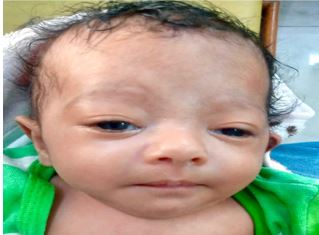William Syndrome Presenting with Life threatening Heart failure: Rare case report
Life threatening Heart failure: Rare case report
Abstract
Williams syndrome (WS), also referred to as Williams-Beuren syndrome, is a rare complex congenital developmental multisystem disorder, occurring in 1 per 20,000 live births, It is characterized by congenital heart defects (CHD), skeletal, renal anomalies, cognitive disorder, social personality disorder and notably dysmorphic Elfin-like facies. Supravalvular aortic stenosis is the most frequent cardiovascular abnormality in WS children. WS occurs as the result of a deletion of approximately 1.5-1.8 Mb on chromosome 7q11.23. The deletion is almost always denovo, however familial cases have been reported. Genetic study is usually required for a definitive diagnosis, but genetic testing is often unavailable in the developing countries and the combination of a typical clinical phenotype and echocardiographic profile helps to confirm the diagnosis. We are reporting a rare case of WS in a 2 month infant presenting with heart failure because of multiple CHD's, including coarctation of aorta (COA), patient ductus arteriosus (PDA), and mild supravalvular pulmonary stenosis (SVPS), severe-pulmonary hypertension and systemic hypertension.
Downloads
References
2. Mervis CB, Robinson BF, Bertrand J. Morris CA, Klein-Tasman BP, Armstrong SC. The williams syndrome cognitive profile. Brain and Cognition. 2000; 44:604-628.
3. Kececioglu D, Kotthoff S, Vogt J. Williams- Beuren syndrome: a 30-year follow-up of natural and postoperative course. European Heart Journal. 1993:14:1458-1464.
4. Eronen M, Peippo M, Hiippala A, et al. Cardiovascular manifestations in 75 patients with Williams’s syndrome. Journal of Medical Genetics. 2002:39:554-558.
5. 5.Curran ME, Atkinson DL, Ewart AK, Morris CA, Leppert MF, Keating MT. The elastin gene is disrupted by a translocation associated with supravalvular aortic stenosis. Cell. 1993; 73:159- 168.
6. Metcalfe K, Rucka AK, Smoot L, et al. Elastin: mutational spectrum in supravalvular aortic stenosis. European Journal of Human Genetics.2000; 8:955-963.
7. Frangiskakis JM, Ewart AK, Morris CA, et al. LIM-kinase 1 hemizygosity implicated in impaired visuospatial constructive cognition. Cell. 1996; 86:59-69.
8. Morris C.A., Demsey S.A., Leonard C.O., Dilts C., Blackburn B.L. Natural history of Williams syndrome. J. Pediatr. 1988; 113:318–326.
9. Sugayama SM, Moisés RL, Wagënfur J, Ikari NM, Abe KT, and Leone C, et al. Williams Beuren syndrome: Cardiovascular abnormalities in 20 patients diagnosed with fluorescence in situ hybridization. Arq Bras Cardiol 2003; 81:468-73.
10. Keating M. Genetic approaches to cardiovascular disease. Supravalvular aortic stenosis, Williams’s syndrome and long QT syndrome. Circulation 1995; 92:142-7.
11. Monfared A, Messner A. Death following tonsillectomy in a child with Williams’s syndrome. Int J Pediatr Otorhinolaryngol 2006; 70:1133-5.
12. Hall EK, Glatz J, Kaplan P, Kaplan BS, Hellinger J, Ernst L, et al. A case report of rapid progressive coarctation and severe middle aortic syndrome in an infant with Williams’s syndrome. Congenit Heart Dis 2009; 4:373-7.

Copyright (c) 2023 Author (s). Published by Siddharth Health Research and Social Welfare Society

This work is licensed under a Creative Commons Attribution 4.0 International License.


 OAI - Open Archives Initiative
OAI - Open Archives Initiative


